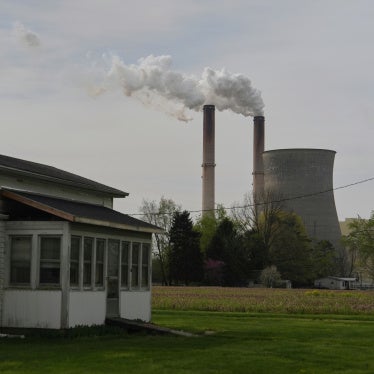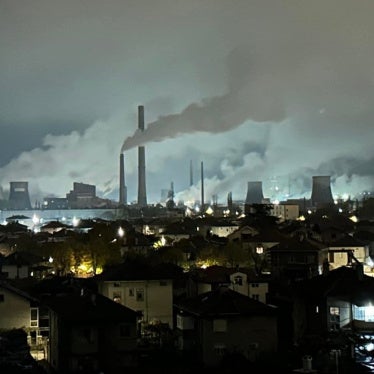At a time when the world is in a deep health crisis, and as children’s rights globally suffer severe setbacks due to the impacts of the COVID-19 pandemic, attention must not be diverted from the environmental emergency that is undermining children’s rights and future prospects around the world.
Each year more than 1.7 million children under the age of five lose their lives as a result of avoidable environmental degradation, while millions more suffer disease, disability, and an array of other forms of harm, some of which can result in lifelong effects. Children’s rights are under threat due to insufficient government measures to address the climate crisis, unprecedented levels of biodiversity loss, exploitation of natural resources, exposure to toxic substances and waste, and widespread pollution of the air, water and soil. Negative effects are disproportionately experienced by girls, children in poverty, indigenous children, children with disabilities and others in vulnerable situations, exposing them to intersecting risks and often violating the principle of non-discrimination.
In light of this, millions of children and youth across the world are calling for more urgent and ambitious action to tackle the root causes and impacts of the global environmental crisis.
For the annual full-day meeting on the rights of the child, Member States should ensure that children’s voices are not only heard, but acted upon, by placing children’s rights and best interests at the core of ambitious and concrete environmental actions and policies, including recognition of a human right to a safe, clean, healthy and sustainable environment. The time is ripe for action.
Recommendations
- Place children’s rights at the heart of environmental policies and action
A general lack of awareness of the many links between a safe and healthy environment on the one hand, and children’s rights on the other, combined with weak political will, represent fundamental obstacles to the respect, protection and fulfilment of children’s rights in the context of environmental measures. The UN Convention on the Rights of the Child (UNCRC) provides a clear normative framework for realizing children’s rights through a healthy environment, but consideration of the treaty remains largely absent from environmental or climate-related policies, laws, and action.
We call on States to:
- Respect, protect and fulfil children’s rights when adopting and implementing environment-related agreements, policies and action to address environmental harm including biodiversity loss and ecosystem destruction, pollution, exposure to hazardous substances and wastes, and climate change, underpinned by a precautionary and preventive approach. Particular attention must be paid to the most marginalised and vulnerable children, and public resources - including regional and international development aid - must be mobilised and allocated accordingly.
- Adequately regulate businesses to ensure that they comply with all applicable environmental laws and the General Comment No. 16 of the UN Committee on the Rights of the Child, including mandatory child rights due diligence and environmental impact assessments in order to identify, prevent and mitigate their environmental impact on child rights, including across their supply chains and within global operations.
- Support and constructively engage in the further development of authoritative guidance on children’s rights and the environment, including through a future General Comment on Child Rights and the Environment to be elaborated and adopted by the UN Committee on the Rights of the Child.
- Recognise the right to a safe, clean, healthy and sustainable environment
The right to a healthy environment should be formally recognised by the United Nations as soon as possible. Such a step would be of particular relevance to children, as well as for future generations, who shoulder a disproportionate share of the burden of environmental harm. It is beyond debate that children are wholly dependent on the natural environment to lead dignified, healthy and fulfilling lives, including a safe climate, clean air, safe water and adequate sanitation, healthy and sustainably produced food, non-toxic environments to learn and play in, and healthy biodiversity and ecosystems.
We call on States to:
- Support the formal recognition of the human right to a safe, clean, healthy and sustainable environment by the UN
- Protect and support child environmental human rights defenders
In too many instances, the views, rights and interests of children go completely unheard in decisions on the environment, leading to adverse outcomes in terms of children’s well-being and development. Furthermore, when acting and speaking out on environmental issues, children often face condescension, intimidation, harassment, reprisals and even violence from authorities or corporations. Children in all their diversity must be empowered to defend their right to a healthy, safe and sustainable environment.
We call on States to:
- Take concrete action to protect the rights to freedom of expression, association and peaceful assembly of child environmental human rights defenders, including online, by providing a safe and enabling environment for initiatives by young people and children to defend human rights relating to the environment, and by promoting a positive narrative around their activities. Pay particular attention to the rights of girls and young woman defending the environment.
- Increase children’s awareness of environmental issues, and strengthen their respect for the natural environment and capacity to respond to environmental challenges, at all stages of education, including by ensuring the availability and accessibility of age-and gender-responsive information on the effects of environmental harm.
- Facilitate public participation in decision-making on the environment, with a particular emphasis on fulfilling children’s right to be heard, including from a young age, and ensuring that their views are given due weight in all environmental processes.
- Ensure that children have access to justice, including effective remedies for and reparation of human rights violations due to environmental harm, for example climate change and exposure to toxic substances and pollution, through child-friendly complaint mechanisms at all levels, including by ratifying the Optional Protocol to the Convention on the Rights of the Child on a communications procedure.
- Address the climate crisis
The climate crisis is a children’s rights crisis. Yet, just 20 per cent of national climate policies mention children, and only 2 per cent of them refer to children’s rights.[1] We call on States to align with the Intergovernmental Declaration on Children, Youth and Climate Action and implement the following commitments:
- Undertake the urgent and transformative action required to limit global temperatures to 1.5°C above pre-industrial levels, in line with best available science and as pursued by the Paris Agreement. This includes the rapid replacement of fossil fuels with rights-respecting renewable energy projects to reduce emissions, and an urgent shift to a circular economy that significantly reduces waste and pollution.
- Respect, protect and fulfil the specific rights of children and young people in the implementation of the Paris Agreement at all levels, including targeted measures in countries’ Nationally Determined Contributions, National Adaptation Plans and long-term low-carbon emission development strategies
- Urgently scale up and accelerate investment in child-responsive adaptation, disaster risk reduction and mitigation measures, with particular attention to marginalized children
- End childhood exposure to pollution and toxic substances
Government failure to address exposure to pollution and to toxic substances and wastes unambiguously violates a wide range of children's rights. Children are born “pre-polluted”. Due to their extremely and uniquely sensitive periods of development, they are not only victims of poisoning that is immediately visible, they also suffer or endure latent impacts from chronic exposure to pollution, to hazardous chemicals and to toxic wastes, causing disease, disability and child mortality later in life.
We call on States to:
- Uphold their duty to prevent childhood exposure to pollution and toxic chemicals as part of States’ obligation to protect children, and ensure that this is reflected in laws and policies based on the child's best interests, as well as through business activities
- Ensure a just and green recovery from COVID-19, and take urgent steps to prevent future pandemics
Environmental degradation is one of the root causes of zoonotic diseases such as COVID-19, which has caused more than 475, 000 deaths to date, and inflicted untold suffering on children. States now have an unprecedented opportunity to implement transformational recovery plans that protect children’s rights and the environment, while addressing the drivers of climate change, biodiversity loss, toxic pollution and zoonotic diseases. Children must also have access to knowledge and skills that can support them in the future in accessing decent jobs in a green economy, including by tackling discriminatory gender norms that prevent girls and young women from accessing STEM education and jobs.
We call on States to:
- Focus recovery plans and investment on fulfilling children’s rights through ‘building back better’ to achieve a just, healthy and sustainable future, accelerating efforts to meet the UN Sustainable Development Goals and the Paris Agreement
- Strengthen rather than weaken environmental regulations and protections, including policies to reduce greenhouse gas emissions.
- Improve access to transformative green skills for children and young people, ensuring such efforts reach girls and young women, through formal and non-formal education and training.
- Strengthen monitoring and reporting on children’s rights and the environment
Monitoring and reporting on the impacts of environmental harm on children’s rights, as well as progress made to fulfil children’s rights in this context, are essential for raising awareness and underpinning more effective and targeted policies and measures.
We call on States to:
- Strengthen monitoring on children’s environmental rights (e.g. childhood exposure-monitoring for adverse physical and mental health impacts linked to the environment), and publish and disseminate age and gender disaggregated information on the results.
- Incorporate the implications of environmental harm on the full enjoyment of children’s rights in their periodic reports to the Committee on the Rights of the Child, their national reports under the Universal Periodic Review, and in their reporting under environmental frameworks and the Sustainable Development Goals.
Signatories:
- Mikiko Otani, Member of the Committee on the Rights of the Child
- David R. Boyd, Special Rapporteur on human rights and the environment
- Baskut Tuncak, Special Rapporteur on human rights and hazardous substances and wastes (toxics)
- The United Nations Children's Fund
- Child Rights Connect
- Children's Environmental Rights Initiative
- Terre des Hommes
- Child Rights International Network
- Franciscans International
- Human Rights Watch
- Child Rights Information Centre Moldova
- Humanium
- Project Dryad
- Marist Australia, Bridge Builders
- Child Rights Coalition Asia
- Save the Children
- Defence for Children International
- Together (Scottish Alliance for Children’s Rights)
- The Global Initiative for Economic, Social and Cultural Rights
- Plan International
- International Child Rights Center
- Environment Africa
- Make Mothers Matter (MMM)
- Associated Country Women of the World
[1] UNICEF (2020), Are Climate Change Policies Child-Sensitive? Available at: https://www.unicef.org/globalinsight/media/976/file/%20Global-Insight-Are-climate-policies-child-sensitive-2020.pdf.







